LAW861: Environmental Planning and Assessment Act and its Implications
VerifiedAdded on 2023/01/12
|22
|3770
|66
Report
AI Summary
This report provides an analysis of the Environmental Planning and Assessment Act (EP&A Act) in New South Wales, focusing on the planning and assessment of development projects. The report outlines the key provisions of the Act, including the roles of different authorities (Minister, local governments), the classification of projects (permissible, prohibited, complying development, State Significant Development), and the importance of environmental impact assessments (EIS). It examines the role of strategic planning, public involvement, and the Construction Environmental Management Plan (CEMP). Furthermore, the report discusses the requirements for EIS, including climate change adaptation, air quality and greenhouse gas assessments, and stormwater management strategies. It also covers legislative provisions, including the EP&A Act 1979 and associated regulations, and the need for public involvement in the development process. The report emphasizes the importance of considering environmental impacts, implementing mitigation measures, and ensuring compliance with relevant environmental performance provisions.
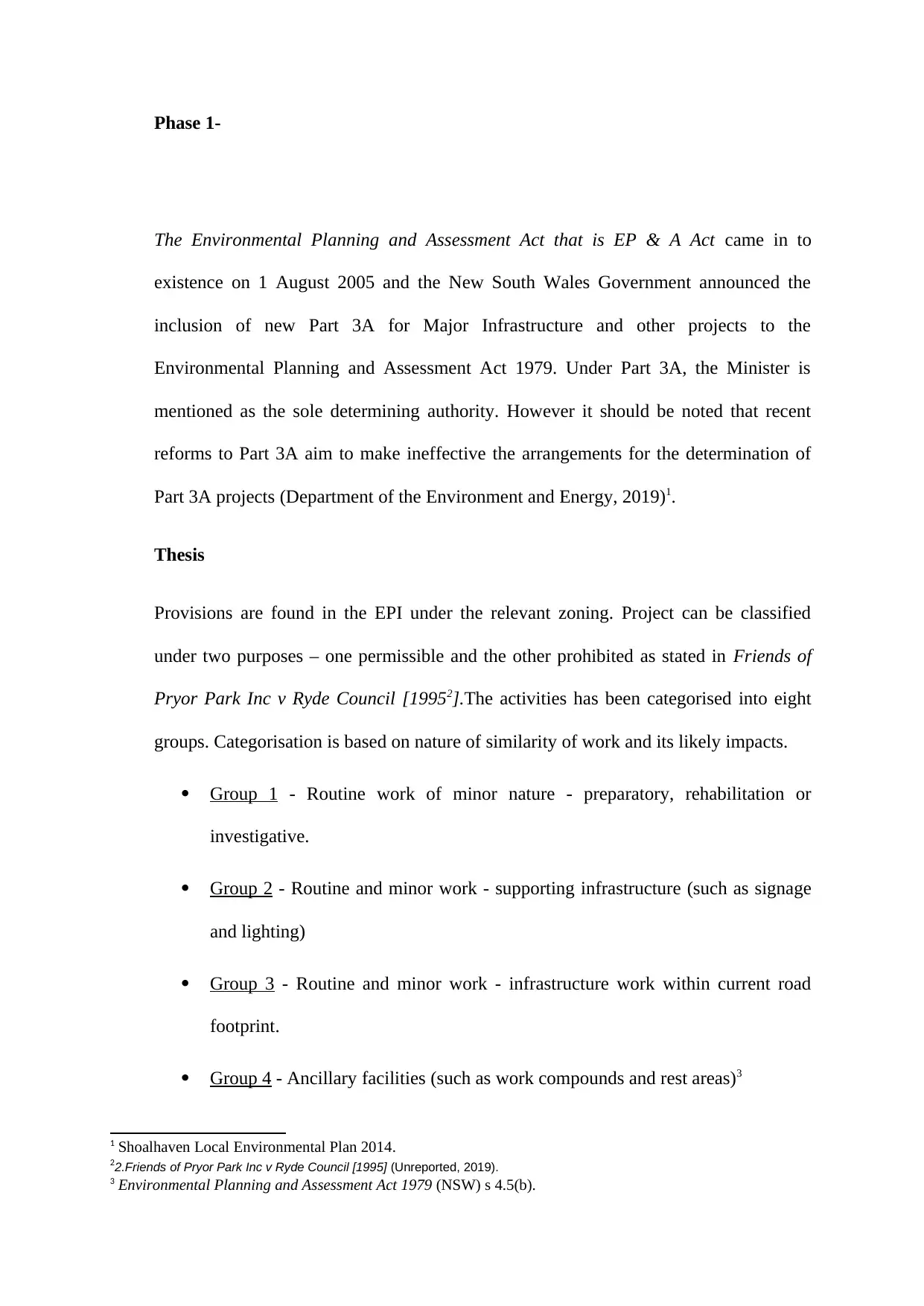
Phase 1-
The Environmental Planning and Assessment Act that is EP & A Act came in to
existence on 1 August 2005 and the New South Wales Government announced the
inclusion of new Part 3A for Major Infrastructure and other projects to the
Environmental Planning and Assessment Act 1979. Under Part 3A, the Minister is
mentioned as the sole determining authority. However it should be noted that recent
reforms to Part 3A aim to make ineffective the arrangements for the determination of
Part 3A projects (Department of the Environment and Energy, 2019)1.
Thesis
Provisions are found in the EPI under the relevant zoning. Project can be classified
under two purposes – one permissible and the other prohibited as stated in Friends of
Pryor Park Inc v Ryde Council [19952].The activities has been categorised into eight
groups. Categorisation is based on nature of similarity of work and its likely impacts.
Group 1 - Routine work of minor nature - preparatory, rehabilitation or
investigative.
Group 2 - Routine and minor work - supporting infrastructure (such as signage
and lighting)
Group 3 - Routine and minor work - infrastructure work within current road
footprint.
Group 4 - Ancillary facilities (such as work compounds and rest areas)3
1 Shoalhaven Local Environmental Plan 2014.
22.Friends of Pryor Park Inc v Ryde Council [1995] (Unreported, 2019).
3 Environmental Planning and Assessment Act 1979 (NSW) s 4.5(b).
The Environmental Planning and Assessment Act that is EP & A Act came in to
existence on 1 August 2005 and the New South Wales Government announced the
inclusion of new Part 3A for Major Infrastructure and other projects to the
Environmental Planning and Assessment Act 1979. Under Part 3A, the Minister is
mentioned as the sole determining authority. However it should be noted that recent
reforms to Part 3A aim to make ineffective the arrangements for the determination of
Part 3A projects (Department of the Environment and Energy, 2019)1.
Thesis
Provisions are found in the EPI under the relevant zoning. Project can be classified
under two purposes – one permissible and the other prohibited as stated in Friends of
Pryor Park Inc v Ryde Council [19952].The activities has been categorised into eight
groups. Categorisation is based on nature of similarity of work and its likely impacts.
Group 1 - Routine work of minor nature - preparatory, rehabilitation or
investigative.
Group 2 - Routine and minor work - supporting infrastructure (such as signage
and lighting)
Group 3 - Routine and minor work - infrastructure work within current road
footprint.
Group 4 - Ancillary facilities (such as work compounds and rest areas)3
1 Shoalhaven Local Environmental Plan 2014.
22.Friends of Pryor Park Inc v Ryde Council [1995] (Unreported, 2019).
3 Environmental Planning and Assessment Act 1979 (NSW) s 4.5(b).
Paraphrase This Document
Need a fresh take? Get an instant paraphrase of this document with our AI Paraphraser

Group 5 - Supporting construction - basins, drains and culverts etc.
Group 6– basic utilities and fencing.
Group 7 – waterways works (such as snag removal and bank stabilisation)
Group 8 - Primary infrastructure construction work (including carriageways,
bridges and batters)4.
4 State Environmental Planning Policy (State and Regional Development) 2011 sch 1 cl 13(1).
Group 6– basic utilities and fencing.
Group 7 – waterways works (such as snag removal and bank stabilisation)
Group 8 - Primary infrastructure construction work (including carriageways,
bridges and batters)4.
4 State Environmental Planning Policy (State and Regional Development) 2011 sch 1 cl 13(1).
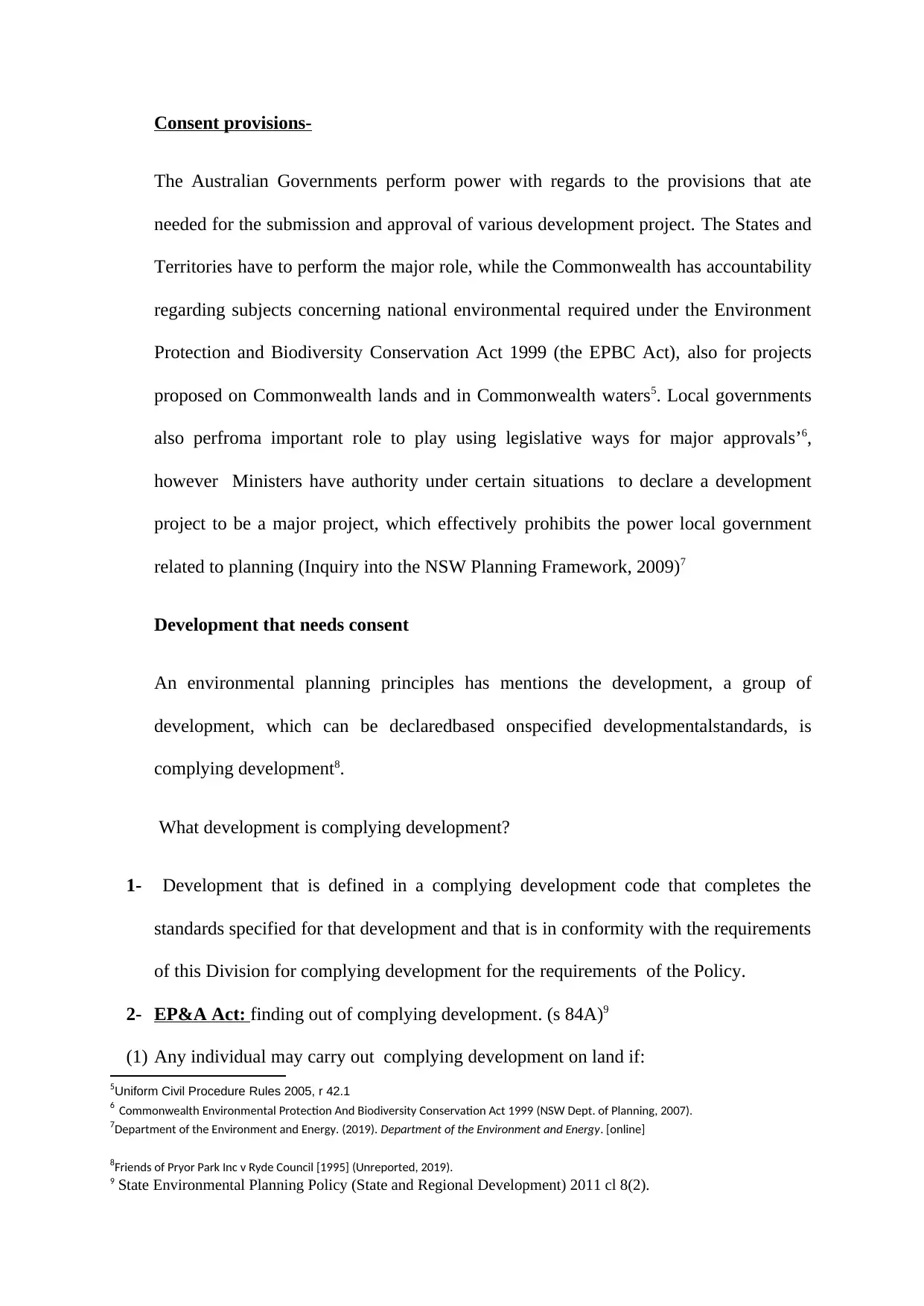
Consent provisions-
The Australian Governments perform power with regards to the provisions that ate
needed for the submission and approval of various development project. The States and
Territories have to perform the major role, while the Commonwealth has accountability
regarding subjects concerning national environmental required under the Environment
Protection and Biodiversity Conservation Act 1999 (the EPBC Act), also for projects
proposed on Commonwealth lands and in Commonwealth waters5. Local governments
also perfroma important role to play using legislative ways for major approvals’6,
however Ministers have authority under certain situations to declare a development
project to be a major project, which effectively prohibits the power local government
related to planning (Inquiry into the NSW Planning Framework, 2009)7
Development that needs consent
An environmental planning principles has mentions the development, a group of
development, which can be declaredbased onspecified developmentalstandards, is
complying development8.
What development is complying development?
1- Development that is defined in a complying development code that completes the
standards specified for that development and that is in conformity with the requirements
of this Division for complying development for the requirements of the Policy.
2- EP&A Act: finding out of complying development. (s 84A)9
(1) Any individual may carry out complying development on land if:
5Uniform Civil Procedure Rules 2005, r 42.1
6 Commonwealth Environmental Protection And Biodiversity Conservation Act 1999 (NSW Dept. of Planning, 2007).
7Department of the Environment and Energy. (2019). Department of the Environment and Energy. [online]
8Friends of Pryor Park Inc v Ryde Council [1995] (Unreported, 2019).
9 State Environmental Planning Policy (State and Regional Development) 2011 cl 8(2).
The Australian Governments perform power with regards to the provisions that ate
needed for the submission and approval of various development project. The States and
Territories have to perform the major role, while the Commonwealth has accountability
regarding subjects concerning national environmental required under the Environment
Protection and Biodiversity Conservation Act 1999 (the EPBC Act), also for projects
proposed on Commonwealth lands and in Commonwealth waters5. Local governments
also perfroma important role to play using legislative ways for major approvals’6,
however Ministers have authority under certain situations to declare a development
project to be a major project, which effectively prohibits the power local government
related to planning (Inquiry into the NSW Planning Framework, 2009)7
Development that needs consent
An environmental planning principles has mentions the development, a group of
development, which can be declaredbased onspecified developmentalstandards, is
complying development8.
What development is complying development?
1- Development that is defined in a complying development code that completes the
standards specified for that development and that is in conformity with the requirements
of this Division for complying development for the requirements of the Policy.
2- EP&A Act: finding out of complying development. (s 84A)9
(1) Any individual may carry out complying development on land if:
5Uniform Civil Procedure Rules 2005, r 42.1
6 Commonwealth Environmental Protection And Biodiversity Conservation Act 1999 (NSW Dept. of Planning, 2007).
7Department of the Environment and Energy. (2019). Department of the Environment and Energy. [online]
8Friends of Pryor Park Inc v Ryde Council [1995] (Unreported, 2019).
9 State Environmental Planning Policy (State and Regional Development) 2011 cl 8(2).
⊘ This is a preview!⊘
Do you want full access?
Subscribe today to unlock all pages.

Trusted by 1+ million students worldwide
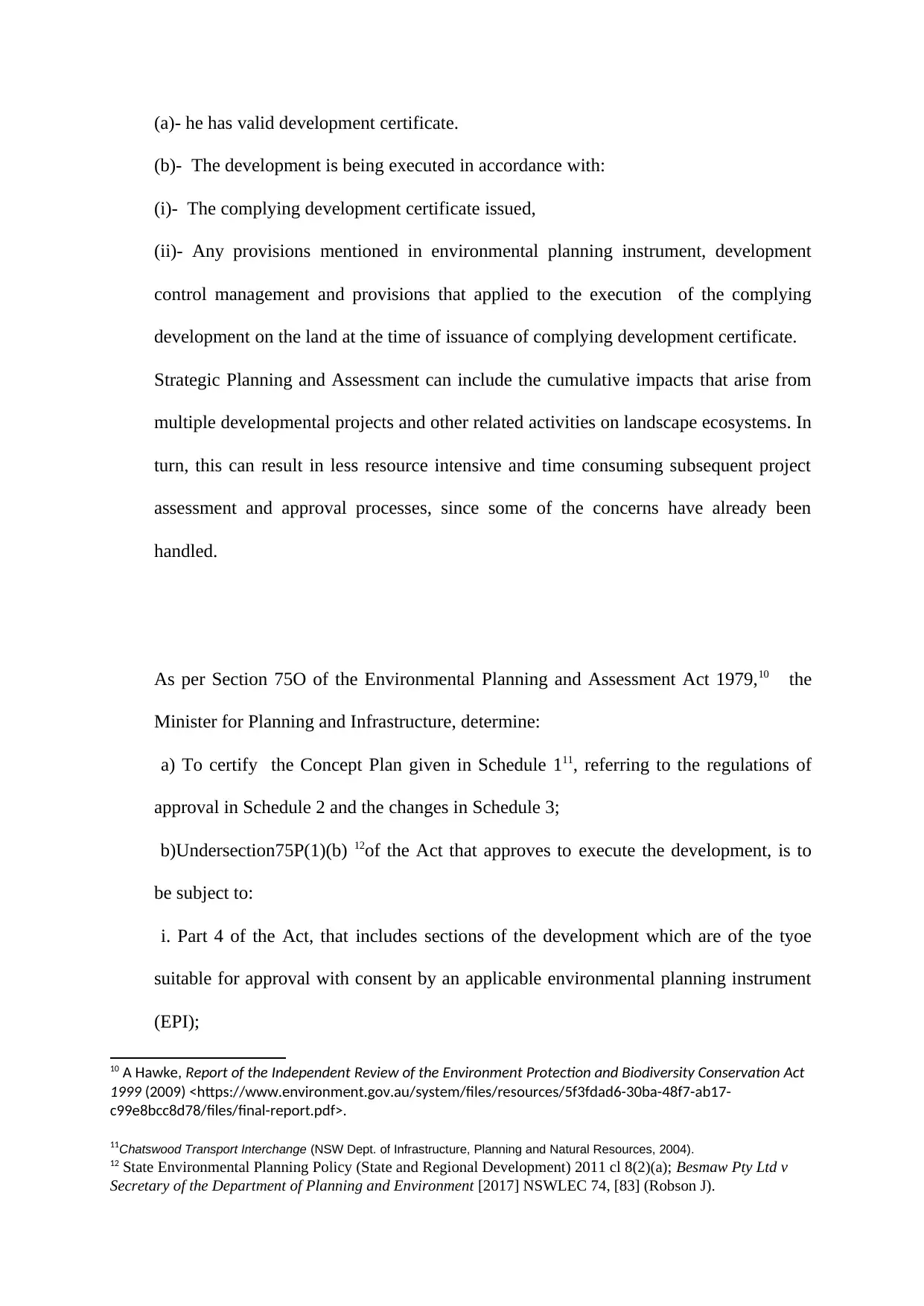
(a)- he has valid development certificate.
(b)- The development is being executed in accordance with:
(i)- The complying development certificate issued,
(ii)- Any provisions mentioned in environmental planning instrument, development
control management and provisions that applied to the execution of the complying
development on the land at the time of issuance of complying development certificate.
Strategic Planning and Assessment can include the cumulative impacts that arise from
multiple developmental projects and other related activities on landscape ecosystems. In
turn, this can result in less resource intensive and time consuming subsequent project
assessment and approval processes, since some of the concerns have already been
handled.
As per Section 75O of the Environmental Planning and Assessment Act 1979,10 the
Minister for Planning and Infrastructure, determine:
a) To certify the Concept Plan given in Schedule 111, referring to the regulations of
approval in Schedule 2 and the changes in Schedule 3;
b)Undersection75P(1)(b) 12of the Act that approves to execute the development, is to
be subject to:
i. Part 4 of the Act, that includes sections of the development which are of the tyoe
suitable for approval with consent by an applicable environmental planning instrument
(EPI);
10 A Hawke, Report of the Independent Review of the Environment Protection and Biodiversity Conservation Act
1999 (2009) <https://www.environment.gov.au/system/files/resources/5f3fdad6-30ba-48f7-ab17-
c99e8bcc8d78/files/final-report.pdf>.
11Chatswood Transport Interchange (NSW Dept. of Infrastructure, Planning and Natural Resources, 2004).
12 State Environmental Planning Policy (State and Regional Development) 2011 cl 8(2)(a); Besmaw Pty Ltd v
Secretary of the Department of Planning and Environment [2017] NSWLEC 74, [83] (Robson J).
(b)- The development is being executed in accordance with:
(i)- The complying development certificate issued,
(ii)- Any provisions mentioned in environmental planning instrument, development
control management and provisions that applied to the execution of the complying
development on the land at the time of issuance of complying development certificate.
Strategic Planning and Assessment can include the cumulative impacts that arise from
multiple developmental projects and other related activities on landscape ecosystems. In
turn, this can result in less resource intensive and time consuming subsequent project
assessment and approval processes, since some of the concerns have already been
handled.
As per Section 75O of the Environmental Planning and Assessment Act 1979,10 the
Minister for Planning and Infrastructure, determine:
a) To certify the Concept Plan given in Schedule 111, referring to the regulations of
approval in Schedule 2 and the changes in Schedule 3;
b)Undersection75P(1)(b) 12of the Act that approves to execute the development, is to
be subject to:
i. Part 4 of the Act, that includes sections of the development which are of the tyoe
suitable for approval with consent by an applicable environmental planning instrument
(EPI);
10 A Hawke, Report of the Independent Review of the Environment Protection and Biodiversity Conservation Act
1999 (2009) <https://www.environment.gov.au/system/files/resources/5f3fdad6-30ba-48f7-ab17-
c99e8bcc8d78/files/final-report.pdf>.
11Chatswood Transport Interchange (NSW Dept. of Infrastructure, Planning and Natural Resources, 2004).
12 State Environmental Planning Policy (State and Regional Development) 2011 cl 8(2)(a); Besmaw Pty Ltd v
Secretary of the Department of Planning and Environment [2017] NSWLEC 74, [83] (Robson J).
Paraphrase This Document
Need a fresh take? Get an instant paraphrase of this document with our AI Paraphraser
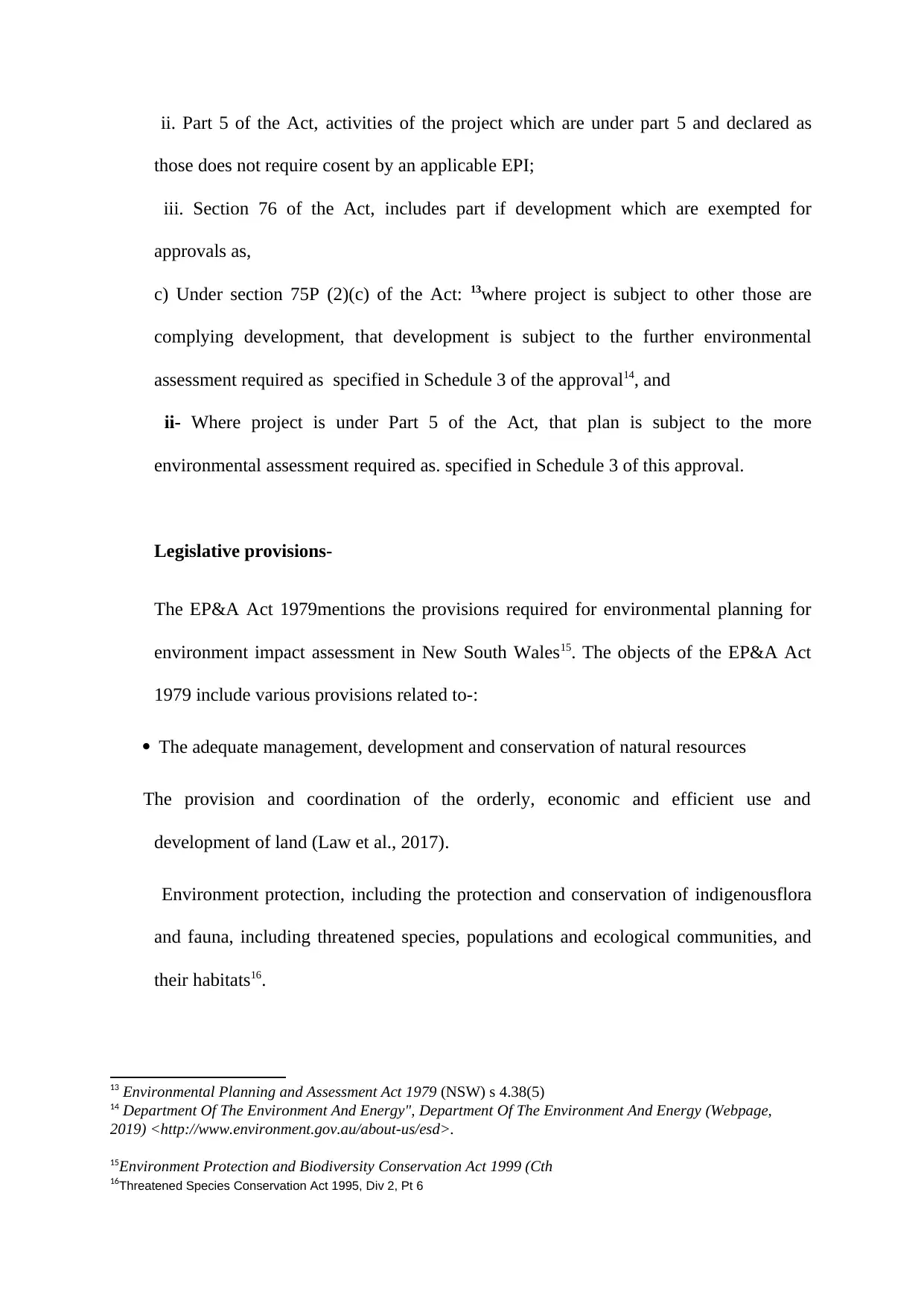
ii. Part 5 of the Act, activities of the project which are under part 5 and declared as
those does not require cosent by an applicable EPI;
iii. Section 76 of the Act, includes part if development which are exempted for
approvals as,
c) Under section 75P (2)(c) of the Act: 13where project is subject to other those are
complying development, that development is subject to the further environmental
assessment required as specified in Schedule 3 of the approval14, and
ii- Where project is under Part 5 of the Act, that plan is subject to the more
environmental assessment required as. specified in Schedule 3 of this approval.
Legislative provisions-
The EP&A Act 1979mentions the provisions required for environmental planning for
environment impact assessment in New South Wales15. The objects of the EP&A Act
1979 include various provisions related to-:
The adequate management, development and conservation of natural resources
The provision and coordination of the orderly, economic and efficient use and
development of land (Law et al., 2017).
Environment protection, including the protection and conservation of indigenousflora
and fauna, including threatened species, populations and ecological communities, and
their habitats16.
13 Environmental Planning and Assessment Act 1979 (NSW) s 4.38(5)
14 Department Of The Environment And Energy", Department Of The Environment And Energy (Webpage,
2019) <http://www.environment.gov.au/about-us/esd>.
15Environment Protection and Biodiversity Conservation Act 1999 (Cth
16Threatened Species Conservation Act 1995, Div 2, Pt 6
those does not require cosent by an applicable EPI;
iii. Section 76 of the Act, includes part if development which are exempted for
approvals as,
c) Under section 75P (2)(c) of the Act: 13where project is subject to other those are
complying development, that development is subject to the further environmental
assessment required as specified in Schedule 3 of the approval14, and
ii- Where project is under Part 5 of the Act, that plan is subject to the more
environmental assessment required as. specified in Schedule 3 of this approval.
Legislative provisions-
The EP&A Act 1979mentions the provisions required for environmental planning for
environment impact assessment in New South Wales15. The objects of the EP&A Act
1979 include various provisions related to-:
The adequate management, development and conservation of natural resources
The provision and coordination of the orderly, economic and efficient use and
development of land (Law et al., 2017).
Environment protection, including the protection and conservation of indigenousflora
and fauna, including threatened species, populations and ecological communities, and
their habitats16.
13 Environmental Planning and Assessment Act 1979 (NSW) s 4.38(5)
14 Department Of The Environment And Energy", Department Of The Environment And Energy (Webpage,
2019) <http://www.environment.gov.au/about-us/esd>.
15Environment Protection and Biodiversity Conservation Act 1999 (Cth
16Threatened Species Conservation Act 1995, Div 2, Pt 6

⊘ This is a preview!⊘
Do you want full access?
Subscribe today to unlock all pages.

Trusted by 1+ million students worldwide
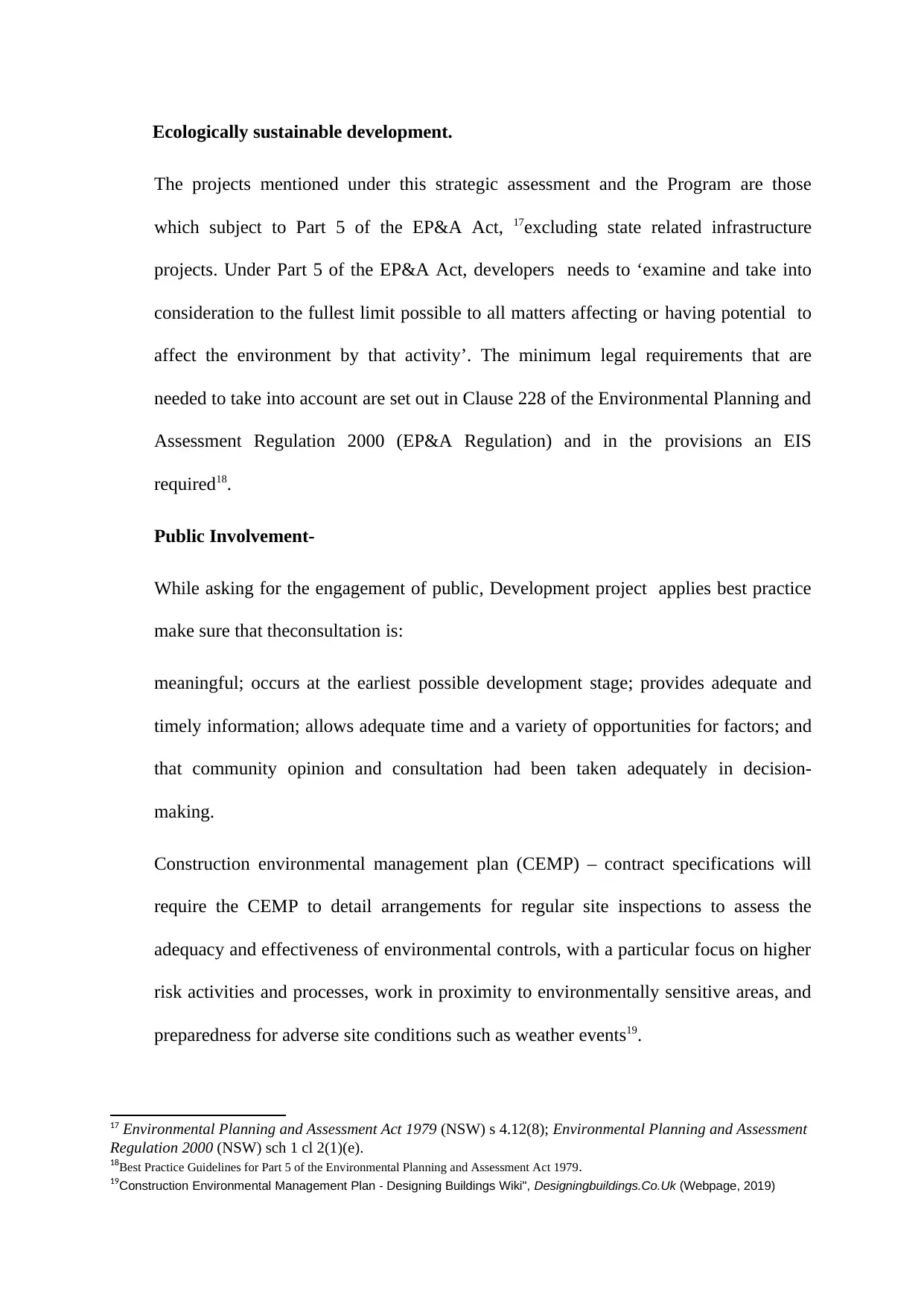
Ecologically sustainable development.
The projects mentioned under this strategic assessment and the Program are those
which subject to Part 5 of the EP&A Act, 17excluding state related infrastructure
projects. Under Part 5 of the EP&A Act, developers needs to ‘examine and take into
consideration to the fullest limit possible to all matters affecting or having potential to
affect the environment by that activity’. The minimum legal requirements that are
needed to take into account are set out in Clause 228 of the Environmental Planning and
Assessment Regulation 2000 (EP&A Regulation) and in the provisions an EIS
required18.
Public Involvement-
While asking for the engagement of public, Development project applies best practice
make sure that theconsultation is:
meaningful; occurs at the earliest possible development stage; provides adequate and
timely information; allows adequate time and a variety of opportunities for factors; and
that community opinion and consultation had been taken adequately in decision-
making.
Construction environmental management plan (CEMP) – contract specifications will
require the CEMP to detail arrangements for regular site inspections to assess the
adequacy and effectiveness of environmental controls, with a particular focus on higher
risk activities and processes, work in proximity to environmentally sensitive areas, and
preparedness for adverse site conditions such as weather events19.
17 Environmental Planning and Assessment Act 1979 (NSW) s 4.12(8); Environmental Planning and Assessment
Regulation 2000 (NSW) sch 1 cl 2(1)(e).
18Best Practice Guidelines for Part 5 of the Environmental Planning and Assessment Act 1979.
19Construction Environmental Management Plan - Designing Buildings Wiki", Designingbuildings.Co.Uk (Webpage, 2019)
The projects mentioned under this strategic assessment and the Program are those
which subject to Part 5 of the EP&A Act, 17excluding state related infrastructure
projects. Under Part 5 of the EP&A Act, developers needs to ‘examine and take into
consideration to the fullest limit possible to all matters affecting or having potential to
affect the environment by that activity’. The minimum legal requirements that are
needed to take into account are set out in Clause 228 of the Environmental Planning and
Assessment Regulation 2000 (EP&A Regulation) and in the provisions an EIS
required18.
Public Involvement-
While asking for the engagement of public, Development project applies best practice
make sure that theconsultation is:
meaningful; occurs at the earliest possible development stage; provides adequate and
timely information; allows adequate time and a variety of opportunities for factors; and
that community opinion and consultation had been taken adequately in decision-
making.
Construction environmental management plan (CEMP) – contract specifications will
require the CEMP to detail arrangements for regular site inspections to assess the
adequacy and effectiveness of environmental controls, with a particular focus on higher
risk activities and processes, work in proximity to environmentally sensitive areas, and
preparedness for adverse site conditions such as weather events19.
17 Environmental Planning and Assessment Act 1979 (NSW) s 4.12(8); Environmental Planning and Assessment
Regulation 2000 (NSW) sch 1 cl 2(1)(e).
18Best Practice Guidelines for Part 5 of the Environmental Planning and Assessment Act 1979.
19Construction Environmental Management Plan - Designing Buildings Wiki", Designingbuildings.Co.Uk (Webpage, 2019)
Paraphrase This Document
Need a fresh take? Get an instant paraphrase of this document with our AI Paraphraser
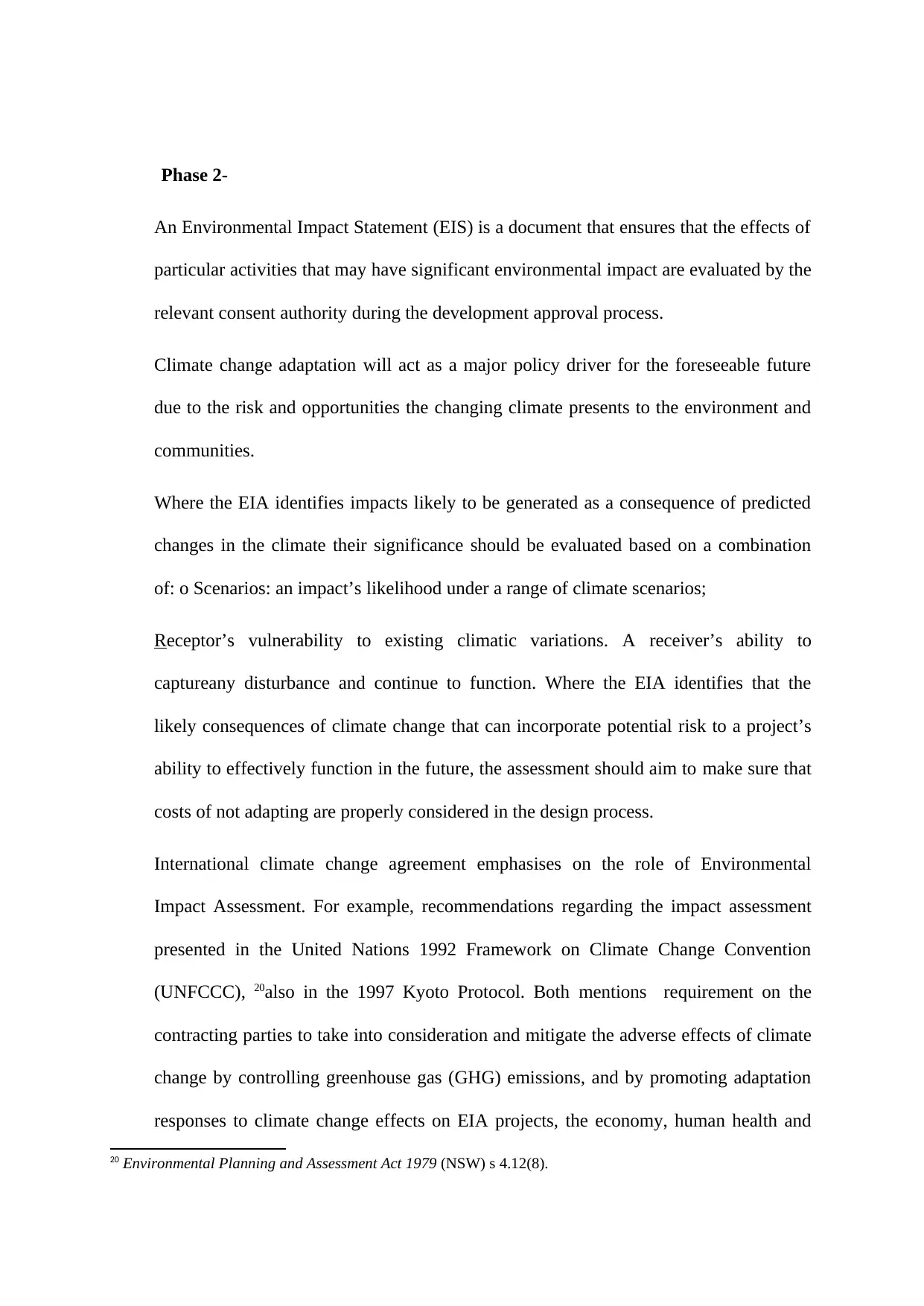
Phase 2-
An Environmental Impact Statement (EIS) is a document that ensures that the effects of
particular activities that may have significant environmental impact are evaluated by the
relevant consent authority during the development approval process.
Climate change adaptation will act as a major policy driver for the foreseeable future
due to the risk and opportunities the changing climate presents to the environment and
communities.
Where the EIA identifies impacts likely to be generated as a consequence of predicted
changes in the climate their significance should be evaluated based on a combination
of: o Scenarios: an impact’s likelihood under a range of climate scenarios;
Receptor’s vulnerability to existing climatic variations. A receiver’s ability to
captureany disturbance and continue to function. Where the EIA identifies that the
likely consequences of climate change that can incorporate potential risk to a project’s
ability to effectively function in the future, the assessment should aim to make sure that
costs of not adapting are properly considered in the design process.
International climate change agreement emphasises on the role of Environmental
Impact Assessment. For example, recommendations regarding the impact assessment
presented in the United Nations 1992 Framework on Climate Change Convention
(UNFCCC), 20also in the 1997 Kyoto Protocol. Both mentions requirement on the
contracting parties to take into consideration and mitigate the adverse effects of climate
change by controlling greenhouse gas (GHG) emissions, and by promoting adaptation
responses to climate change effects on EIA projects, the economy, human health and
20 Environmental Planning and Assessment Act 1979 (NSW) s 4.12(8).
An Environmental Impact Statement (EIS) is a document that ensures that the effects of
particular activities that may have significant environmental impact are evaluated by the
relevant consent authority during the development approval process.
Climate change adaptation will act as a major policy driver for the foreseeable future
due to the risk and opportunities the changing climate presents to the environment and
communities.
Where the EIA identifies impacts likely to be generated as a consequence of predicted
changes in the climate their significance should be evaluated based on a combination
of: o Scenarios: an impact’s likelihood under a range of climate scenarios;
Receptor’s vulnerability to existing climatic variations. A receiver’s ability to
captureany disturbance and continue to function. Where the EIA identifies that the
likely consequences of climate change that can incorporate potential risk to a project’s
ability to effectively function in the future, the assessment should aim to make sure that
costs of not adapting are properly considered in the design process.
International climate change agreement emphasises on the role of Environmental
Impact Assessment. For example, recommendations regarding the impact assessment
presented in the United Nations 1992 Framework on Climate Change Convention
(UNFCCC), 20also in the 1997 Kyoto Protocol. Both mentions requirement on the
contracting parties to take into consideration and mitigate the adverse effects of climate
change by controlling greenhouse gas (GHG) emissions, and by promoting adaptation
responses to climate change effects on EIA projects, the economy, human health and
20 Environmental Planning and Assessment Act 1979 (NSW) s 4.12(8).
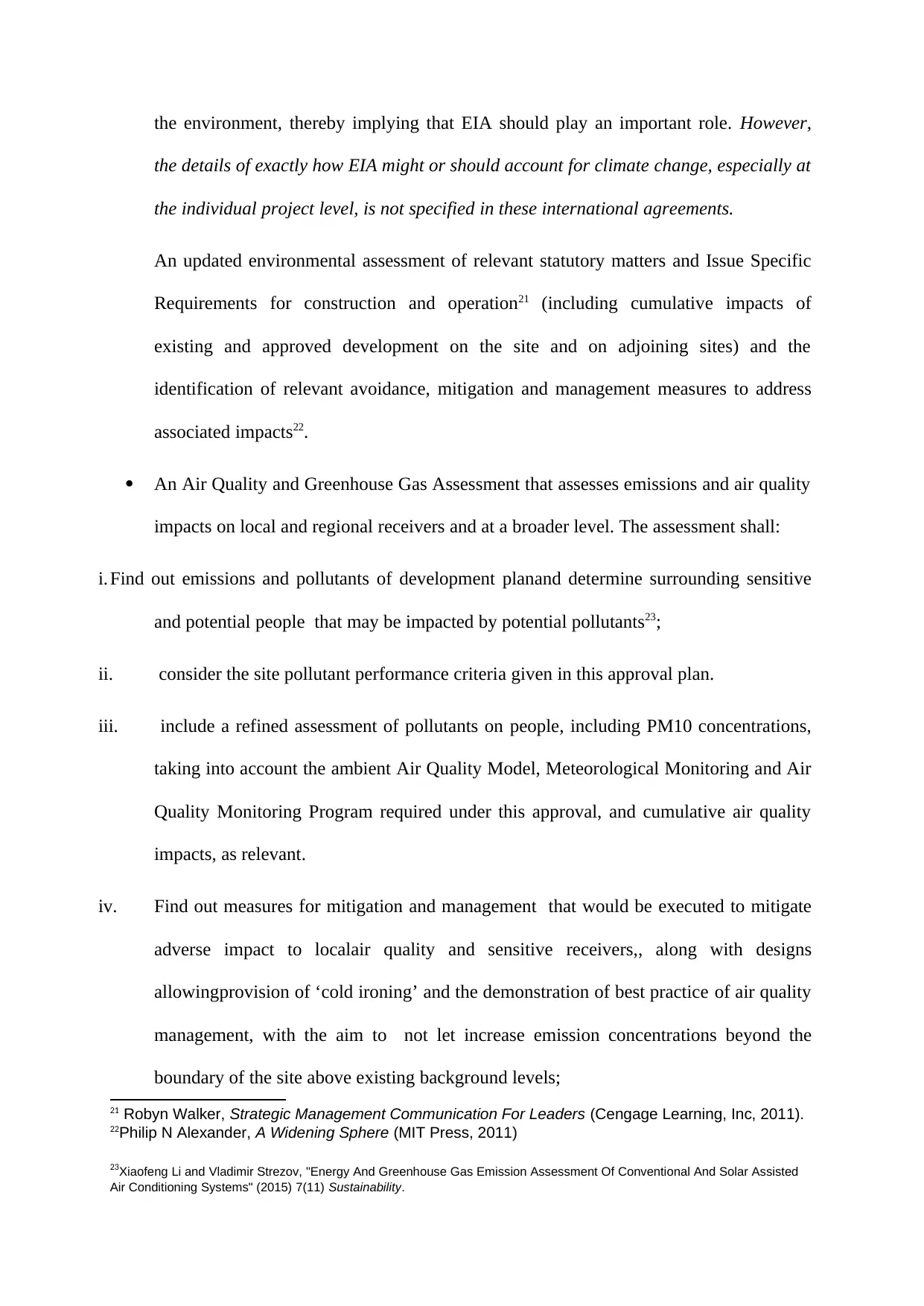
the environment, thereby implying that EIA should play an important role. However,
the details of exactly how EIA might or should account for climate change, especially at
the individual project level, is not specified in these international agreements.
An updated environmental assessment of relevant statutory matters and Issue Specific
Requirements for construction and operation21 (including cumulative impacts of
existing and approved development on the site and on adjoining sites) and the
identification of relevant avoidance, mitigation and management measures to address
associated impacts22.
An Air Quality and Greenhouse Gas Assessment that assesses emissions and air quality
impacts on local and regional receivers and at a broader level. The assessment shall:
i. Find out emissions and pollutants of development planand determine surrounding sensitive
and potential people that may be impacted by potential pollutants23;
ii. consider the site pollutant performance criteria given in this approval plan.
iii. include a refined assessment of pollutants on people, including PM10 concentrations,
taking into account the ambient Air Quality Model, Meteorological Monitoring and Air
Quality Monitoring Program required under this approval, and cumulative air quality
impacts, as relevant.
iv. Find out measures for mitigation and management that would be executed to mitigate
adverse impact to localair quality and sensitive receivers,, along with designs
allowingprovision of ‘cold ironing’ and the demonstration of best practice of air quality
management, with the aim to not let increase emission concentrations beyond the
boundary of the site above existing background levels;
21 Robyn Walker, Strategic Management Communication For Leaders (Cengage Learning, Inc, 2011).
22Philip N Alexander, A Widening Sphere (MIT Press, 2011)
23Xiaofeng Li and Vladimir Strezov, "Energy And Greenhouse Gas Emission Assessment Of Conventional And Solar Assisted
Air Conditioning Systems" (2015) 7(11) Sustainability.
the details of exactly how EIA might or should account for climate change, especially at
the individual project level, is not specified in these international agreements.
An updated environmental assessment of relevant statutory matters and Issue Specific
Requirements for construction and operation21 (including cumulative impacts of
existing and approved development on the site and on adjoining sites) and the
identification of relevant avoidance, mitigation and management measures to address
associated impacts22.
An Air Quality and Greenhouse Gas Assessment that assesses emissions and air quality
impacts on local and regional receivers and at a broader level. The assessment shall:
i. Find out emissions and pollutants of development planand determine surrounding sensitive
and potential people that may be impacted by potential pollutants23;
ii. consider the site pollutant performance criteria given in this approval plan.
iii. include a refined assessment of pollutants on people, including PM10 concentrations,
taking into account the ambient Air Quality Model, Meteorological Monitoring and Air
Quality Monitoring Program required under this approval, and cumulative air quality
impacts, as relevant.
iv. Find out measures for mitigation and management that would be executed to mitigate
adverse impact to localair quality and sensitive receivers,, along with designs
allowingprovision of ‘cold ironing’ and the demonstration of best practice of air quality
management, with the aim to not let increase emission concentrations beyond the
boundary of the site above existing background levels;
21 Robyn Walker, Strategic Management Communication For Leaders (Cengage Learning, Inc, 2011).
22Philip N Alexander, A Widening Sphere (MIT Press, 2011)
23Xiaofeng Li and Vladimir Strezov, "Energy And Greenhouse Gas Emission Assessment Of Conventional And Solar Assisted
Air Conditioning Systems" (2015) 7(11) Sustainability.
⊘ This is a preview!⊘
Do you want full access?
Subscribe today to unlock all pages.

Trusted by 1+ million students worldwide
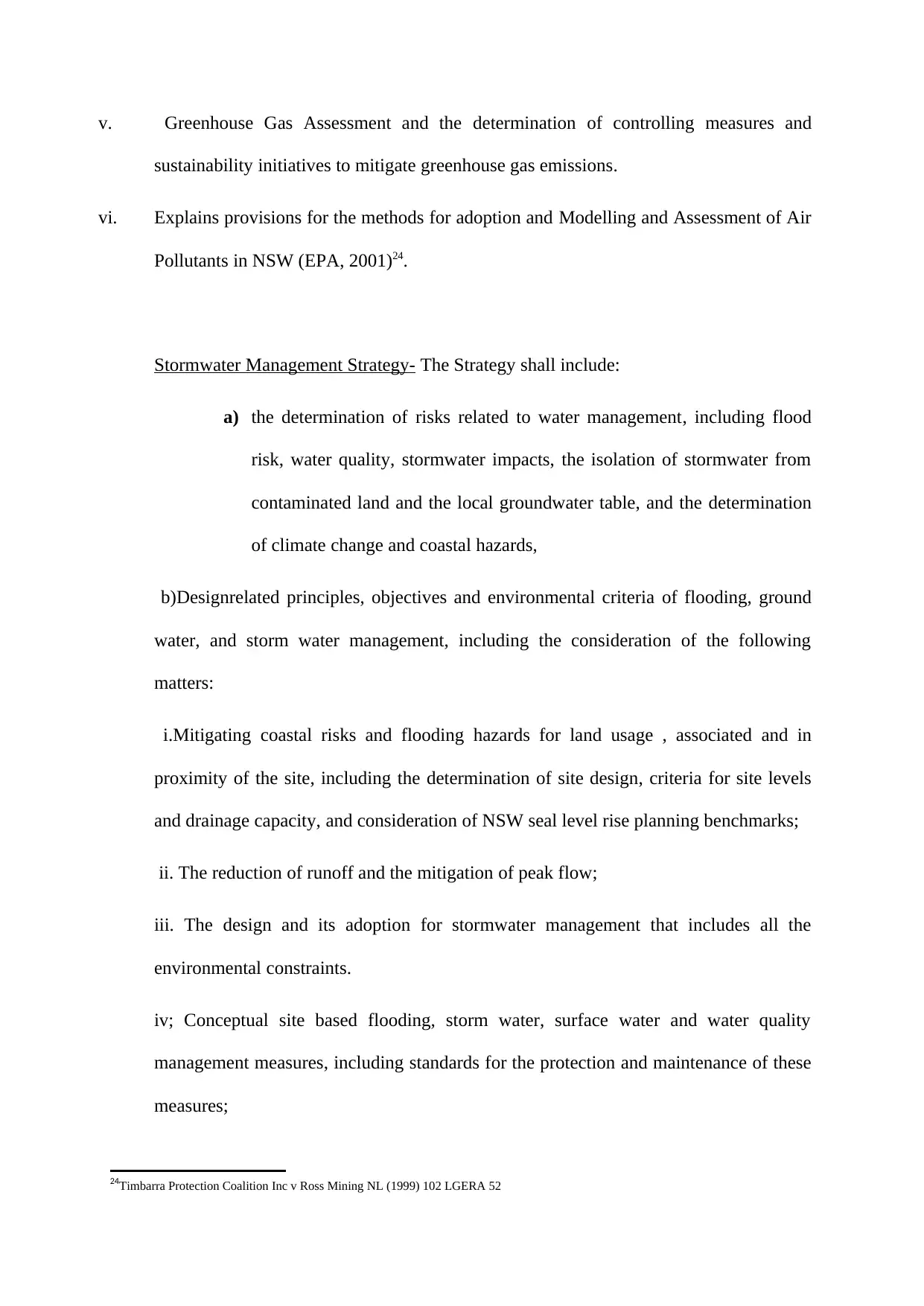
v. Greenhouse Gas Assessment and the determination of controlling measures and
sustainability initiatives to mitigate greenhouse gas emissions.
vi. Explains provisions for the methods for adoption and Modelling and Assessment of Air
Pollutants in NSW (EPA, 2001)24.
Stormwater Management Strategy- The Strategy shall include:
a) the determination of risks related to water management, including flood
risk, water quality, stormwater impacts, the isolation of stormwater from
contaminated land and the local groundwater table, and the determination
of climate change and coastal hazards,
b)Designrelated principles, objectives and environmental criteria of flooding, ground
water, and storm water management, including the consideration of the following
matters:
i.Mitigating coastal risks and flooding hazards for land usage , associated and in
proximity of the site, including the determination of site design, criteria for site levels
and drainage capacity, and consideration of NSW seal level rise planning benchmarks;
ii. The reduction of runoff and the mitigation of peak flow;
iii. The design and its adoption for stormwater management that includes all the
environmental constraints.
iv; Conceptual site based flooding, storm water, surface water and water quality
management measures, including standards for the protection and maintenance of these
measures;
24Timbarra Protection Coalition Inc v Ross Mining NL (1999) 102 LGERA 52
sustainability initiatives to mitigate greenhouse gas emissions.
vi. Explains provisions for the methods for adoption and Modelling and Assessment of Air
Pollutants in NSW (EPA, 2001)24.
Stormwater Management Strategy- The Strategy shall include:
a) the determination of risks related to water management, including flood
risk, water quality, stormwater impacts, the isolation of stormwater from
contaminated land and the local groundwater table, and the determination
of climate change and coastal hazards,
b)Designrelated principles, objectives and environmental criteria of flooding, ground
water, and storm water management, including the consideration of the following
matters:
i.Mitigating coastal risks and flooding hazards for land usage , associated and in
proximity of the site, including the determination of site design, criteria for site levels
and drainage capacity, and consideration of NSW seal level rise planning benchmarks;
ii. The reduction of runoff and the mitigation of peak flow;
iii. The design and its adoption for stormwater management that includes all the
environmental constraints.
iv; Conceptual site based flooding, storm water, surface water and water quality
management measures, including standards for the protection and maintenance of these
measures;
24Timbarra Protection Coalition Inc v Ross Mining NL (1999) 102 LGERA 52
Paraphrase This Document
Need a fresh take? Get an instant paraphrase of this document with our AI Paraphraser
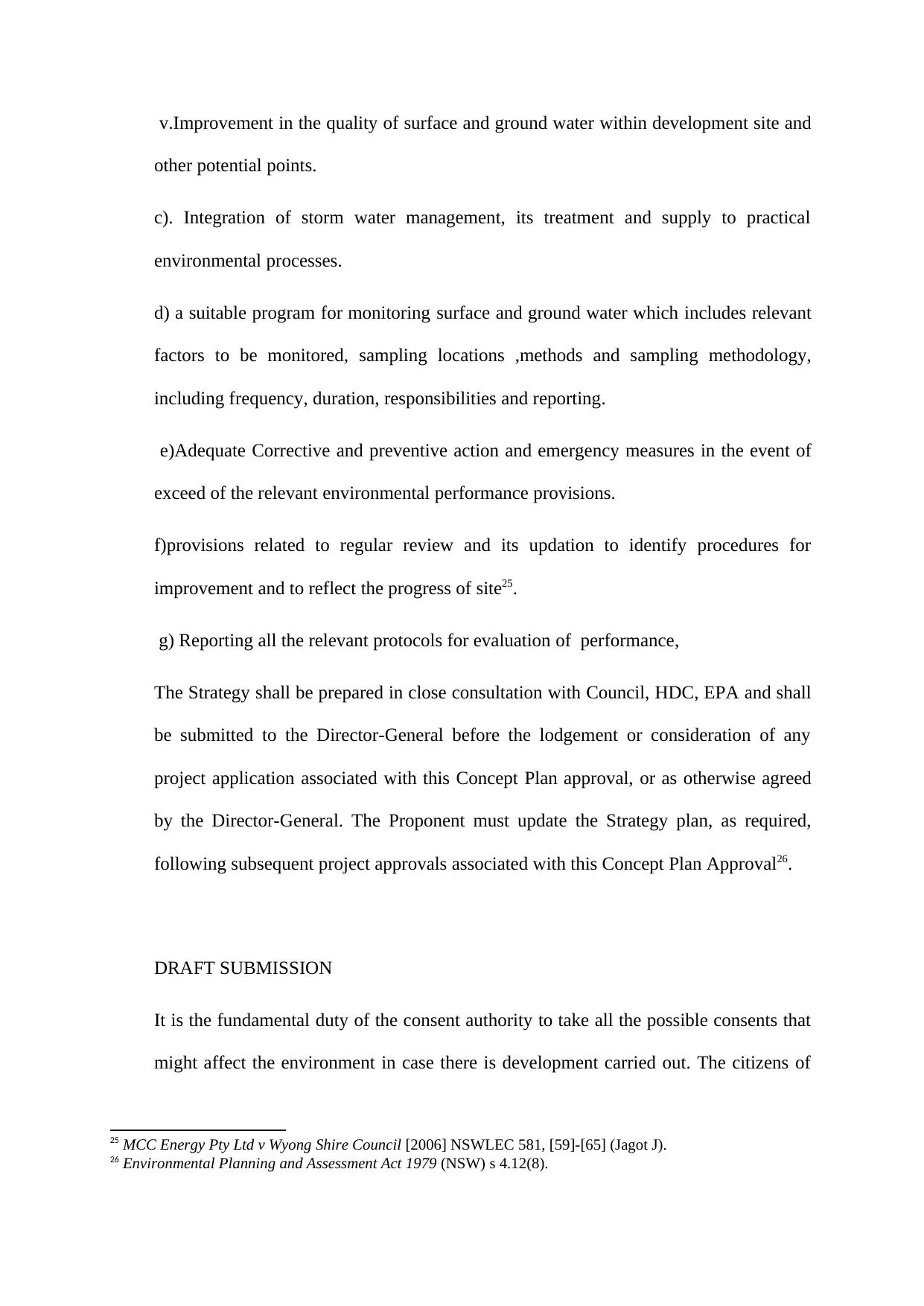
v.Improvement in the quality of surface and ground water within development site and
other potential points.
c). Integration of storm water management, its treatment and supply to practical
environmental processes.
d) a suitable program for monitoring surface and ground water which includes relevant
factors to be monitored, sampling locations ,methods and sampling methodology,
including frequency, duration, responsibilities and reporting.
e)Adequate Corrective and preventive action and emergency measures in the event of
exceed of the relevant environmental performance provisions.
f)provisions related to regular review and its updation to identify procedures for
improvement and to reflect the progress of site25.
g) Reporting all the relevant protocols for evaluation of performance,
The Strategy shall be prepared in close consultation with Council, HDC, EPA and shall
be submitted to the Director-General before the lodgement or consideration of any
project application associated with this Concept Plan approval, or as otherwise agreed
by the Director-General. The Proponent must update the Strategy plan, as required,
following subsequent project approvals associated with this Concept Plan Approval26.
DRAFT SUBMISSION
It is the fundamental duty of the consent authority to take all the possible consents that
might affect the environment in case there is development carried out. The citizens of
25 MCC Energy Pty Ltd v Wyong Shire Council [2006] NSWLEC 581, [59]-[65] (Jagot J).
26 Environmental Planning and Assessment Act 1979 (NSW) s 4.12(8).
other potential points.
c). Integration of storm water management, its treatment and supply to practical
environmental processes.
d) a suitable program for monitoring surface and ground water which includes relevant
factors to be monitored, sampling locations ,methods and sampling methodology,
including frequency, duration, responsibilities and reporting.
e)Adequate Corrective and preventive action and emergency measures in the event of
exceed of the relevant environmental performance provisions.
f)provisions related to regular review and its updation to identify procedures for
improvement and to reflect the progress of site25.
g) Reporting all the relevant protocols for evaluation of performance,
The Strategy shall be prepared in close consultation with Council, HDC, EPA and shall
be submitted to the Director-General before the lodgement or consideration of any
project application associated with this Concept Plan approval, or as otherwise agreed
by the Director-General. The Proponent must update the Strategy plan, as required,
following subsequent project approvals associated with this Concept Plan Approval26.
DRAFT SUBMISSION
It is the fundamental duty of the consent authority to take all the possible consents that
might affect the environment in case there is development carried out. The citizens of
25 MCC Energy Pty Ltd v Wyong Shire Council [2006] NSWLEC 581, [59]-[65] (Jagot J).
26 Environmental Planning and Assessment Act 1979 (NSW) s 4.12(8).
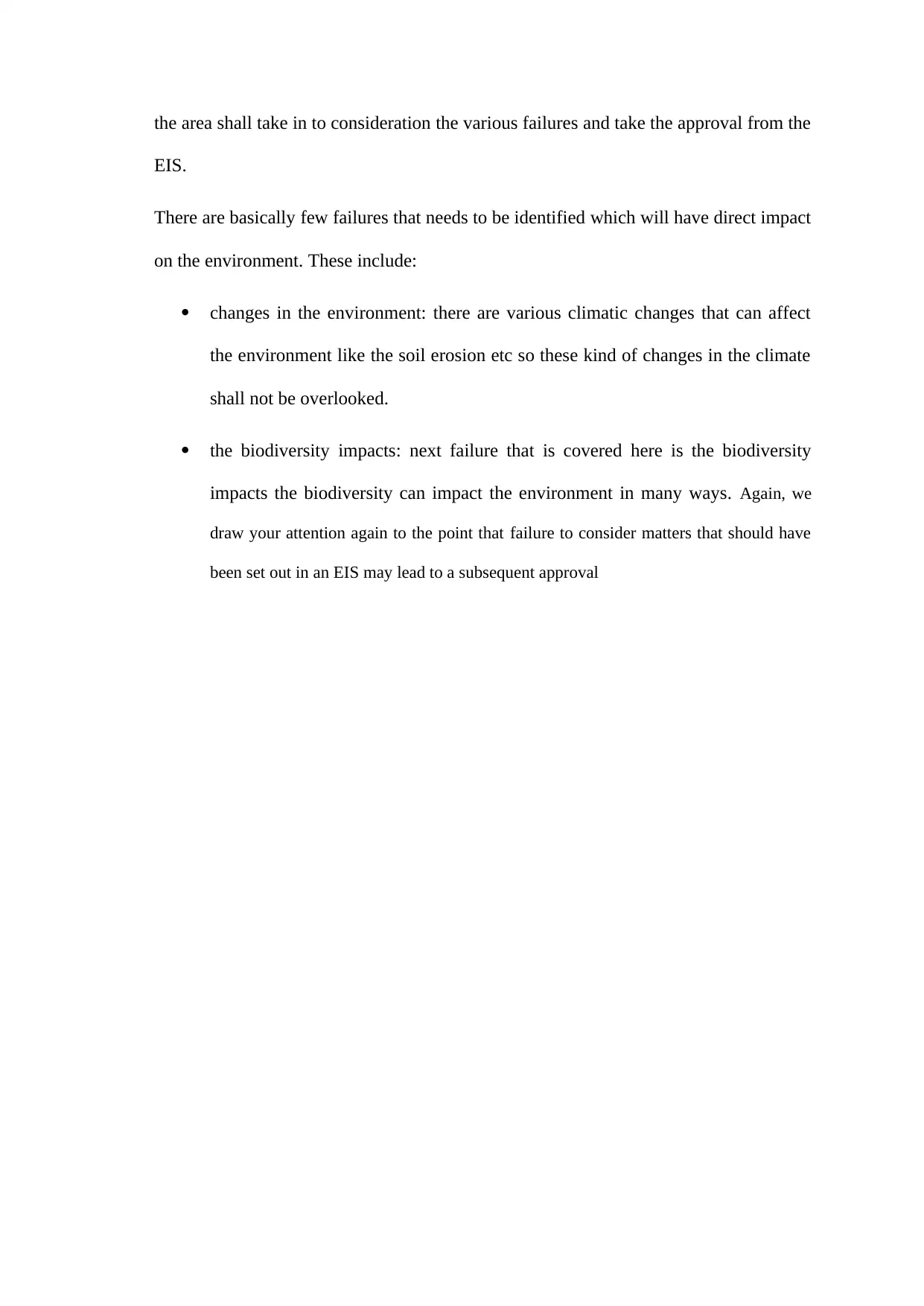
the area shall take in to consideration the various failures and take the approval from the
EIS.
There are basically few failures that needs to be identified which will have direct impact
on the environment. These include:
changes in the environment: there are various climatic changes that can affect
the environment like the soil erosion etc so these kind of changes in the climate
shall not be overlooked.
the biodiversity impacts: next failure that is covered here is the biodiversity
impacts the biodiversity can impact the environment in many ways. Again, we
draw your attention again to the point that failure to consider matters that should have
been set out in an EIS may lead to a subsequent approval
EIS.
There are basically few failures that needs to be identified which will have direct impact
on the environment. These include:
changes in the environment: there are various climatic changes that can affect
the environment like the soil erosion etc so these kind of changes in the climate
shall not be overlooked.
the biodiversity impacts: next failure that is covered here is the biodiversity
impacts the biodiversity can impact the environment in many ways. Again, we
draw your attention again to the point that failure to consider matters that should have
been set out in an EIS may lead to a subsequent approval
⊘ This is a preview!⊘
Do you want full access?
Subscribe today to unlock all pages.

Trusted by 1+ million students worldwide
1 out of 22
Related Documents
Your All-in-One AI-Powered Toolkit for Academic Success.
+13062052269
info@desklib.com
Available 24*7 on WhatsApp / Email
![[object Object]](/_next/static/media/star-bottom.7253800d.svg)
Unlock your academic potential
Copyright © 2020–2025 A2Z Services. All Rights Reserved. Developed and managed by ZUCOL.





